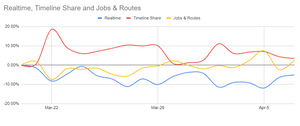Fleet management is a complex process that encounters several unexpected challenges, leading to delayed deliveries. Sound familiar? The reason might be hiding in plain sight - on your vehicle dashboard - inaccurate odometer readings.
An odometer is an essential instrument for tracking the vehicle’s usage and maintenance needs. It can either be a mechanical instrument or a digital device that measures the distance covered by the vehicle. There are several benefits associated with accurate odometer readings:
- Setting automated maintenance schedules
- Fleet-wide vehicle performance assessment
- Precise vehicle usage billing
Integrating odometer readings with real-time vehicle location and diagnostic updates enables fleet operators to identify vehicle usage patterns, optimize routes, and detect driving inconsistencies. Such data provides actionable insights to fleet managers for improving fleet efficiency and safety while minimizing operational costs.
Difference Between Odometer & Speedometer
Although both devices work in conjunction with one another, their purposes of use are entirely different. Let’s have a look at the differences between the two -
8 Reasons Why Odometer Tracking is Critical for Optimizing Fleet Performance
The Indian odometer market import shipments have shown an overall upward trend with a CAGR of 11% from 2020 to 2024. However, there was a decline in the growth rate observed between 2023 and 2024, signifying a slowdown in the momentum. That little number flashing on the vehicle's dashboard might seem insignificant, but this information is crucial for saving time, money, and other hassles associated with fleet management. The benefits of capturing accurate odometer readings include:
Dependable Mileage Data
Monitoring the mileage readings on the odometer readily provides accurate information about the distance covered by each vehicle in the fleet. This information enables efficient scheduling of fleet maintenance services, tracking of fuel efficiency, and accurate client billing based on the distance covered.
Accurate Maintenance Scheduling
Mileage trend analysis and historical maintenance details enable fleet managers to anticipate maintenance requirements accurately, preventing sudden breakdowns, extending the vehicle’s lifetime, and lowering overall operational expenses.
Fuel Efficiency Analysis
Data on the distance covered helps fleet managers in analysing fuel efficiency trends across the fleet to identify inefficiencies, optimize routes, and execute strategies for lower fuel consumption.
Controlling Costs
Measuring and analysing costs incurred related to vehicle usage - fuel expenses, maintenance costs, depreciation values, and insurance - helps fleet managers in cost management and proper resource allocation.
Ensuring Regulatory Compliance
Monitoring odometer data ensures adherence to regulatory requirements concerning vehicle usage and reporting. Several jurisdictions have rules governing odometer readings that are required for tax calculation and vehicle inspections.
Optimizing Asset Management
Monitoring vehicle mileage aids fleet managers in supervising vehicle usage in the fleet, identifying underused assets, and making informed decisions regarding fleet size and structure.
Aiding Warranty Management
Accurate odometer readings are required for efficiently managing vehicle warranties. Fleet managers can ensure that vehicles get the warranty-covered repairs and services within specified mileage limits, thus maximizing the warranty benefits and minimizing non-essential expenses.
Determining Insurance Premiums
Accurate odometer readings are essential for smooth warranty-period claims. Certain insurance providers consider odometer readings for finalizing insurance premiums payable. Reliable vehicle run data helps fleet managers negotiate favourable insurance rates based on actual vehicle usage.
Odometer Rollback - A Practical Fleet Issue & Ways to Spot It
Odometer rollback is another term used for tampering with the odometer readings, manually or digitally, to alter the vehicle’s mileage record and reduce the actual distance covered, which impacts several other aspects of the vehicle. Typically, this is done to increase the resale value or market price of the vehicle. Now, in the trucking industry, the effects are wider than in other vehicles. Here are a few ways in which odometer fraud can be detected in fleets -
Vehicle History Report
These reports often include information about historical odometer readings, deed transfers, and reported incidents. Any inconsistency in the records would be a sign of odometer fraud.
Internal Inspection
A rough comparison of the state of wear and tear within the vehicle and the reported mileage is often indicative of any odometer fraud.
Service Records
Detailed maintenance and repair records can be insightful in understanding the tenure of the vehicle’s usage.
Odometer and Dashboard Inspection
If there are visible signs of tampering in and around the odometer and dashboard, or if there are mismatched screws, scratches, or any other signs of physical damage, then it also indicates odometer rollback.
Comparison With External Wear and Tear
Running a quick comparison between the vehicle’s exterior condition and the reported mileage is also a clue. Excessive signs of wear on these parts suggest higher vehicle usage than claimed.
VIN Decoding
The Vehicle Identification Number (VIN) can also be decoded to attain information about the vehicle’s history, including earlier mileage readings.
History of Title and Ownership
Frequent ownership transfers, especially over a short time period, is a potential red flag.
Unrealistic Offer
If the price offered seems too generous for its condition - model, make, and mileage included - then it’s good to be cautious.
Online Database Verification
Some jurisdictions maintain databases of reported odometer readings during inspections and emission tests. Such records should be looked into for inconsistencies.
Smarter Odometer Tracking With Telematics - Engineered by Fleetx
The truck fleet environment, especially on Indian roads, relies on the distance driven for metrics such as fuel cost, vehicle wear and tear, tyre life, vehicle replacement planning, and more. Tampered mileage data, coupled with tamper alerts from Fleetx, addresses the risk of faulty vehicle usage, inaccurate maintenance scheduling, disproportionate cost/km, and even fuel theft details.
- Automatic Mileage Data & Verification: The telematics or OBD data is integrated with the Fleetx platform to map vehicle mileage automatically, instead of relying on manual driver logs.
- Usage-Based Maintenance Alerts: Mileage data is linked with the maintenance module, enabling service reminders based on the meter reading, time interval, mileage, and engine hours.
- Tamper Detection: Odometer tampering or unusual mileage data is also detected by comparing the expected distance metrics and flagging any anomalies. Tamper alerts are generated if the odometer data changes unusually.
- The Analytics Edge: The mileage data also aids in prompting other actionable analytics, including cost/km, vehicle utilization, and fuel efficiency.
- Mapping Asset Lifecycle: Accurate mileage data facilitates decisions on vehicle replacement, resale value, and costing.
Pro Tips to Stay Immune from the Effects of Odometer Tampering
Amendment to Indian standard AIS-059 has made it a regulatory requirement to record the vehicle odometer value daily and to store the data for at least 365 days. To lower the risk of odometer tampering and other issues that might lead to inaccurate readings, fleet managers and operators can utilize these tips -
Partner or Lease Judiciously
Fleet operators can work with trusted vendors and dealers, and lease vehicles wisely to ensure accurate vehicle records.
Pre-Trip Assessment
Adding a quick pre-trip inspection routine helps drivers identify any discrepancies or malfunctions to report them for timely repairs or adjustments.
Maintain Detailed Service Records
Having in-depth maintenance data, along with odometer readings, helps ensure incredible data accuracy that helps in cross-referencing mileage data with servicing history to identify any possible inconsistencies.
Follow the Periodic Calibration Schedules
Similar to any other device, odometers can develop inefficiencies over time. Regular calibrations with a certified technician ensure the authenticity of the reading.
Implement GPS Tracking Technology
A GPS tracking system may not be a direct substitute for odometer tracking, but GPS tracking data can offer beneficial insights in case of odometer discrepancies by comparing location data with the mileage recorded, demonstrating potential data inconsistencies.
Embrace Automation & Future-Proof Your Profits
The automated odometer reading system from Fleetx captures accurate mileage data to enable improved predictive maintenance and fleet management - without any manual effort. The device captures odometer readings in real time, providing much more detailed insights.
The advanced fleet management software shares all the necessary data needed to improve the fleet’s operational efficiency, cost control, and asset management. The centralized dashboard merges departmental data, aiding machine learning algorithms in analyzing historical mileage patterns and predicting future maintenance requirements. Fleetx empowers fleet managers to make informed decisions that reduce operational costs, improve vehicle performance, and maximize ROIs across the fleet.
What is the significance of accurate odometer readings in fleet management?
Precise odometer readings aid fleet managers in planning maintenance, tracking fuel efficiency, factual client billing, and accurate vehicle health assessment. It also simplifies cost control, asset utilization, warranty claims, and premium calculations. Thus, reliable mileage data keeps the fleet running without any sudden hiccups.
How is an odometer different from a speedometer?
The odometer’s function is to measure the total distance covered by the vehicle since its manufacture or reset, while a speedometer displays the real-time speed of the moving vehicle.
What is odometer rollback, and how does it impact fleets?
Odometer tampering, also known as rollback, is the manipulation of mileage data to display fake usage. For fleets, this can mess up maintenance schedules, cost/km calculations, fuel usage data - all resulting in massive financial losses for the fleet owner
How does Fleetx facilitate odometer discrepancy detection & prevent fraud?
Integrating vehicle telematics and OBD data, Fleetx automatically captures real-time mileage. The system flags any abnormal or exceptional mileage fluctuations, triggers tamper alerts, and validates the distance covered with estimated movement. Such automation eliminates manual efforts, generates accurate maintenance triggers, aids in cost/km analysis, and aids in lifecycle planning.




